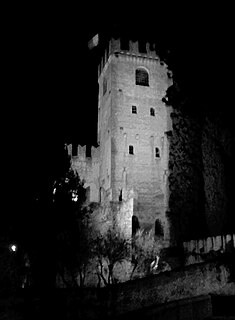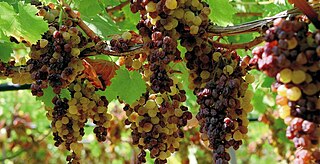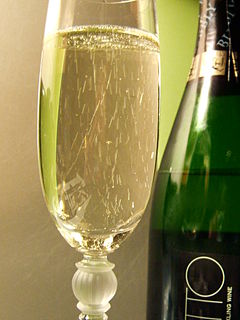Veneto is a wine region in north-eastern Italy, one of a group of three highly productive Italian regions known collectively as the Tre Venezie (after the Venetian Republic), which is a large area comprised today of the Italian regions of Friuli Venezia-Giulia, Alto Adige and Trentino, and Veneto. The Veneto is the biggest Denominazione di Origine Controllata (DOC) producer of the three. Although the Tre Venezie collectively produce more red wine than white, the Veneto region produces more whites under DOC and is home to the Soave and Prosecco wines.

Soave ( is a dry white Italian wine from the Veneto region in northeast Italy, principally around the city of Verona. Within the Soave region are both a Denominazione di Origine Controllata (DOC) zone and a Denominazione di Origine Controllata e Garantita (DOCG) designation known as Soave Superiore with both zones being further sub-divided into a general and classico designation for the wines produced in the heartland of the Soave region around the sloping vineyards of Verona.

Prosecco is an Italian white wine. Prosecco controlled designation of origin can be spumante, frizzante, or tranquillo. It is made from Glera grapes, formerly known also as Prosecco, but other grape varieties may be included. The following varieties can be included with Glera up to a maximum of 15 per cent of the total: Verdiso, Bianchetta Trevigiana, Perera, Chardonnay, Pinot Bianco, Pinot Grigio and Pinot Noir. The name Prosecco is derived from the Italian village of Prosecco near Trieste, where the grape and wine is said to have originated.
The region is protected from the harsh northern European climate by the Alps, the foothills of which form the Veneto's northern extremes. These cooler climes are well-suited to white varieties like Garganega (the main grape for Soave wines), [1] while the warmer Adriatic coastal plains, river valleys, and Garda Lake zone are the places where the renowned Valpolicella, Amarone and Bardolino DOC reds are produced.

The Alps are the highest and most extensive mountain range system that lies entirely in Europe, separating Southern from Central and Western Europe and stretching approximately 1,200 kilometres (750 mi) across eight Alpine countries : France, Switzerland, Italy, Monaco, Liechtenstein, Austria, Germany, and Slovenia. The mountains were formed over tens of millions of years as the African and Eurasian tectonic plates collided. Extreme shortening caused by the event resulted in marine sedimentary rocks rising by thrusting and folding into high mountain peaks such as Mont Blanc and the Matterhorn. Mont Blanc spans the French–Italian border, and at 4,810 m (15,781 ft) is the highest mountain in the Alps. The Alpine region area contains about a hundred peaks higher than 4,000 metres (13,000 ft).
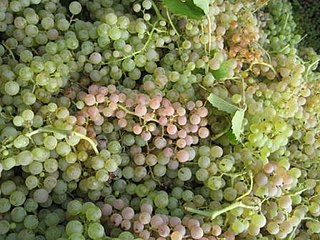
Garganega is a variety of white Italian wine grape widely grown in the Veneto region of North East Italy, particularly in the provinces of Verona and Vicenza. It is Italy's 6th most widely planted white grape. It forms the basis of Venetian white wine Soave and is also a major portion of the blend used to make Gambellara.

Valpolicella is a viticultural zone of the province of Verona, Italy, east of Lake Garda. The hilly agricultural and marble-quarrying region of small holdings north of the Adige is famous for wine production. Valpolicella ranks just after Chianti in total Italian Denominazione di Origine Controllata (DOC) wine production.
In Veneto, two different wine areas are clearly distinguishable: an Eastern part, close to the Venice Lagoon between the hills of Treviso, the plain of Piave river and Adriatic coast, where it is typical to produce the famous Prosecco (Glera), and other varieties are grown like Merlot, Carmenere, Verduzzo, Raboso Piave, Refosco, Tocai, Verdiso, Marzemino; and the Western part, close to Garda Lake and the city of Verona, famous for the wines based on the varieties Corvina, Rondinella, Garganega, Trebbiano of Soave, and Oseleta.

Veneto is one of the 20 regions of Italy. Its population is about five million, ranking fifth in Italy. The region's capital is Venice.

Treviso is a city and comune in the Veneto region of northern Italy. It is the capital of the province of Treviso and the municipality has 84,669 inhabitants : some 3,000 live within the Venetian walls or in the historical and monumental center, some 80,000 live in the urban center proper while the city hinterland has a population of approximately 170,000. The city is home to the headquarters of clothing retailer Benetton, Sisley, Stefanel, Geox, Diadora and Lotto Sport Italia, appliance maker De'Longhi, and bicycle maker Pinarello.

Merlot is a dark blue-colored wine grape variety, that is used as both a blending grape and for varietal wines. The name Merlot is thought to be a diminutive of merle, the French name for the blackbird, probably a reference to the color of the grape. Its softness and "fleshiness", combined with its earlier ripening, makes Merlot a popular grape for blending with the sterner, later-ripening Cabernet Sauvignon, which tends to be higher in tannin.
In the central part of the Veneto the winemaking transitions between the varieties and styles of the Eastern and Western parts. In that area you can find the Colli Euganei, the hills close to Padua, that is a special Mediterranean microclimatic zone; it is even famous for the Moscato fior d'arancio production, a sparkling dessert wine.

Padua is a city and comune in Veneto, northern Italy. It is the capital of the province of Padua and the economic and communications hub of the area. Padua's population is 214,000. The city is sometimes included, with Venice and Treviso, in the Padua-Treviso-Venice Metropolitan Area (PATREVE) which has a population of c. 2,600,000.
Another area in the North-center of Veneto, close to Asiago, is Breganze, where the dessert wine Torcolato is produced with the Vespaiolo grape.

Asiago is the name of both a major Italian Protected Designation of Origin (PDO) cheese and a minor township in the surrounding plateau region in the Province of Vicenza in the Veneto region of Northeastern Italy. It is near the border between the Veneto and Trentino-Alto Adige/Südtirol regions in the foothills of the Alps, and about equidistant (60 km) from the major cities of Trento to the west and Vicenza to the south. The Asiago region is the origin of Asiago cheese. The town was the site of a major battle between Austrian and Italian forces on the Alpine Front of World War I. It is a major ski resort destination as well as the site of the Astrophysical Observatory of Asiago, operated by the University of Padua.
The traditional vine training system of the eastern part is the Sylvoz system, today replaced by the Guyot system, while in the western part there is more traditionally the Pergola system. Veneto's growers use modern growing methods and systems in the vineyard and for wine making. While most of the 'classic' wines from this area are based on native grape varieties, like Glera (formerly known as Prosecco) and Verduzzo, high demand for Veneto wines in the European and US markets has galvanized the region's producers into experimentation with Cabernets, Chardonnay and Pinot varieties, among others. One of Italy's leading wine schools, Conegliano, is based here and the nation's most important wine fair, Vinitaly, takes place each spring in Verona. [2]
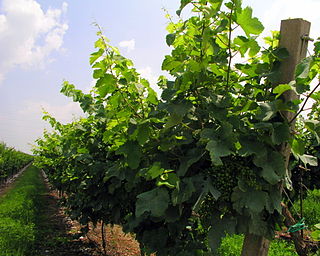
Glera is a white variety of grape of Slovenian origin, which was brought to the village of Prosecco from Slovenia's Karst region. Glera was, until 2009, mostly referred to as Prosecco.
Verduzzo is a white Italian wine grape grown predominantly in the Friuli-Venezia Giulia region of northeast Italy. It is also found in significant plantings in the Piave Denominazione di origine controllata (DOC) of the Veneto region, though some of these plantings may be of the separate Verduzzo Trevigiano variety. Verduzzo Friulano is used in varietal and blended wines, many of which fall under DOC as well as vino da tavola designations, that range in style from dry to late harvest wines. According to wine expert Oz Clarke, most of the sweeter examples of Verduzzo can be found in the Friuli-Venezia Giulia with the grape being used for progressively drier styles of the wine the further west into the Veneto.

Chardonnay is a green-skinned grape variety used in the production of white wine. The variety originated in the Burgundy wine region of eastern France, but is now grown wherever wine is produced, from England to New Zealand. For new and developing wine regions, growing Chardonnay is seen as a "rite of passage" and an easy entry into the international wine market.
Veneto is the 8th largest region of Italy in land mass, and a population of 4,371,000 ranks it 6th in that regard. It has over 90,000 hectares (220,000 acres) of vineyards, of which 35,400 are acclaimed DOC. Annual production totals 8,500,000 hectolitres, 1,700,000 or 21% of which is DOC, making it the biggest DOC producer in Italy. White wine accounts for 55% of the DOC production in Veneto. [3]


